Discovered buried deep within Temple XIII in 1994, the Tomb of the Red Queen of Palenque is one of the most important finds at the ancient Maya city. The Tomb of the Red Queen is one of the few burials found in Mesoamerica where the deceased was interred in a sarcophagus. Royal burials were normally placed on a bench surrounded by bulky personal goods, including pots, carpets, hides and furniture, along with precious commodities, such as jade and other semi-precious stones. This style of burial was a break from tradition and only allowed for precious stones and jewellery to be offered to help the deceased on their treacherous journey through the underworld. She wore and eerie death mask made from 280 pieces of malachite painstakingly pieced together and was accompanied with a treasure of 1140 pieces of precious stone (mainly jadeite). She also took two companions with her to the afterlife, a young boy of around ten, who had been decapitated, and a 30 year-old female, who had her beating heart extracted and offered to the gods before being stabbed multiple times to extract her blood.
Both the entombed body and the limestone sarcophagus had been embalmed with a red dye called cinnabar (mercury sulphide), which stained the bones as the flesh decomposed to leave a startling red skeleton. Analysis of the fully-intact skeleton demonstrated the deceased was female and from the riches present and the method of burial, it was clear that this was an incredibly important female. Therefore, the tomb became known as the Tomb of the Red Queen of Palenque, even though no-one was really sure who she was or why she warranted such an extravagant burial.
Who was buried in the Tomb of the Red Queen?
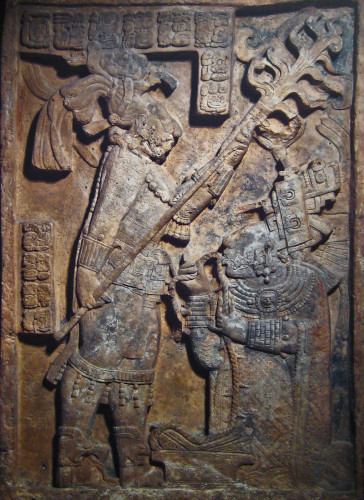 W0578L: Yaxchilan’s Lintel 24The mothers of future or current kings were highly regarded in Maya culture and were often depicted seated with or behind the king. These powerful women are also portrayed pulling thorned cords through piercings in their tongue as part of a blood-letting ritual that were designed to produce visions of the ancestors and spirits of the supernatural world (see fig W0578L, Lintel 24 from Yaxchilan). This painful act demonstrated their willingness to sacrifice themselves to the gods and demonstrated their spiritual potency. These portrayals illustrate that such women were highly regarded, because the only other people known to perform this ritual were the kings and high-priests who were ordained by the gods themselves. It is clear from the grandeur of the Tomb of the Red Queen at Palenque, that the woman buried within would have been one of these important women. The monuments that describe the history of Palenque describe three woman of such stature: Yohl Ik Naal, the first and only Queen of Palenque; Sak K’uk, the mother of Pakal; and Tz’akbu Ajaw, Pakal’s wife of almost 50 years.
W0578L: Yaxchilan’s Lintel 24The mothers of future or current kings were highly regarded in Maya culture and were often depicted seated with or behind the king. These powerful women are also portrayed pulling thorned cords through piercings in their tongue as part of a blood-letting ritual that were designed to produce visions of the ancestors and spirits of the supernatural world (see fig W0578L, Lintel 24 from Yaxchilan). This painful act demonstrated their willingness to sacrifice themselves to the gods and demonstrated their spiritual potency. These portrayals illustrate that such women were highly regarded, because the only other people known to perform this ritual were the kings and high-priests who were ordained by the gods themselves. It is clear from the grandeur of the Tomb of the Red Queen at Palenque, that the woman buried within would have been one of these important women. The monuments that describe the history of Palenque describe three woman of such stature: Yohl Ik Naal, the first and only Queen of Palenque; Sak K’uk, the mother of Pakal; and Tz’akbu Ajaw, Pakal’s wife of almost 50 years.
The most powerful of these three women was probably Yohl Ik Nahl, who ruled Palenque between 683AD and 604AD. During her 20 year reign, Yohl Ik Naal extended the political boundaries of Palenque and started constructing a monumental city to impose Palenque’s increasing power and authority. Unfortunately, this expansion came at a price, as it attracted the unwanted attention of the distant kingdom of Calakmul who attacked the city in 603AD. 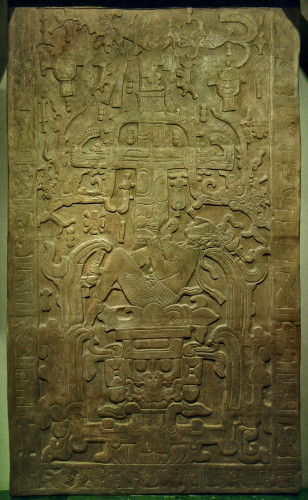 Pakal’s Sarcophagus Lid Although Yohl Ik Naal managed to survive, it is probable that she did so by leaving the city and taking refuge at nearby Tortuguero. She died just a year later, leaving Palenque in a state of flux. Despite this calamitous end, Yohl Ik Naal had set Palenque on a path that would eventually lead to glory and the great king Pakal would recognise her importance by listing her twice on his infamous carved sarcophagus lid.
Pakal’s Sarcophagus Lid Although Yohl Ik Naal managed to survive, it is probable that she did so by leaving the city and taking refuge at nearby Tortuguero. She died just a year later, leaving Palenque in a state of flux. Despite this calamitous end, Yohl Ik Naal had set Palenque on a path that would eventually lead to glory and the great king Pakal would recognise her importance by listing her twice on his infamous carved sarcophagus lid.
Yohl Ik Naal’s son, Aj’ne Yohl Mat, took the throne following her death, but may not have held court at Palenque. This period is poorly understood, but in 611AD Calakmul took the unusual step of sacking the city and destroying its holy sanctuary, the Sak Nuk Nah1 (White Bone House) – effectively killing the city, when normally an opponent would look to take the king captive and hold the city to ransom. Aj’ne Yohl Mat and his father both died the following year, in 612AD, again suggesting that Calakmul who wanted the city and its divine rulers eradicated. It is then that Yohl Ik Naal’s daughter, Sak K’uk, rose to prominence and began the lengthy task of rebuilding the city, restoring its spiritual power and reinstating its divine lineage. Although never officially the queen, Sak K’uk was instrumental in leading Palenque back from death and guiding her son, K’inich Janab Pakal, to become Palenque’s most prolific ruler and one of the most powerful rulers of the Classic Era. Sak K’uk is pictured on the walls of Pakal’s palace awarding him the crown in 615AD. Pakal was just 12 years old and would have been under the strict guidance of Sak K’uk as they continued to rebuild the city, but even once Pakal had matured, Sak K’uk continued to hold court until her death on 12th September 640AD – this is evidenced in the fact that Pakal did not begin his own building projects until 647AD, when he completed a remote temple known as El Olvidado.
It is highly likely that Sak K’uk was instrumental in organising the marriage of Pakal in 626AD to Tz’akbu Ajaw, the 16 year-old daughter of a nobleman from Ox Te ‘Kuh in Tabasco. Tz’akbu Ajaw is thought to have been a descendent of the original noble lineage of Palenque and the marriage was almost certainly designed by Sak K’uk to reaffirm the divine lineage. Pakal and Tz’akbu Ajaw went on to transform Palenque into a powerful kingdom and eventually gave birth to three sons, Kan Bahlam II, K’an Joy Chitam II, and Tiwol Chan Mat, all of whom would play important roles in the history of Palenque over the following century. However, Tz’akbu Ajaw and Pakal’s relationship would have been severely tested in its early years, with it taking 9 years to produce their first heir, Kan Bahlam II, who was born May 23rd, 635AD. It then took a further 9 years to produce a second heir, with K’an Joy Chitam II born on November 5th, 644AD. Their third child, Tiwol Chan Mat, was born November 5th, 648AD, when Tz’akbu Ajaw would have been 38 – an age at which, even in modern times, childbirth can be risky and lead to serious complications. Despite her late pregnancies, she lived a long and illustrious life and eventually perished on November 16th, 672AD, aged 62.
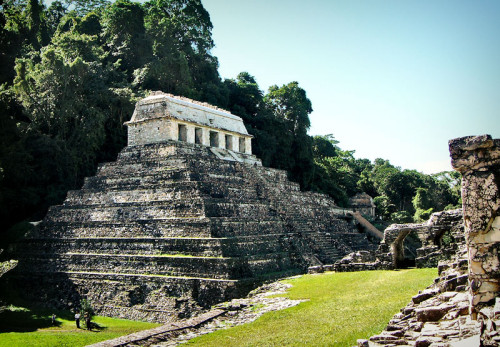 W0469: Temple of Inscriptions With three powerful women coming in close succession, each living equally long and successful lives and each bearing children who would go on to rule the Kingdom, it is remarkably difficult to determine exactly which would have been sufficiently adored to be laid to rest in the remarkable Tomb of the Red Queen. The Tomb of the Red Queen is located within Temple XIII, which is the central of a trio of north-facing structures, with the easternmost being the Temple of Inscriptions – the mausoleum of Pakal the Great (the entrance to the Tomb of the Red Queen can be seen in fig. W0649 beneath the wicker awning just beyond the Temple of Inscriptions). Pakal was also unusually interred in a sarcophagus, wearing an ornate jade mask and embalmed with cinnabar. The proximity of the two tombs and the near identical way in which the deceased were buried demonstrates there was a close connection between Pakal and the Tomb of the Red Queen. Unfortunately, this doesn’t help identify the Red Queen of Palenque, because Pakal had a close relationship to all three women: Yohl Ik Naal was his Grandmother, Sak K’uk his Mother, and Tz’akbu Ajaw his wife. Therefore, scientific analysis was needed to determine who the Tomb of the Red Queen was for.
W0469: Temple of Inscriptions With three powerful women coming in close succession, each living equally long and successful lives and each bearing children who would go on to rule the Kingdom, it is remarkably difficult to determine exactly which would have been sufficiently adored to be laid to rest in the remarkable Tomb of the Red Queen. The Tomb of the Red Queen is located within Temple XIII, which is the central of a trio of north-facing structures, with the easternmost being the Temple of Inscriptions – the mausoleum of Pakal the Great (the entrance to the Tomb of the Red Queen can be seen in fig. W0649 beneath the wicker awning just beyond the Temple of Inscriptions). Pakal was also unusually interred in a sarcophagus, wearing an ornate jade mask and embalmed with cinnabar. The proximity of the two tombs and the near identical way in which the deceased were buried demonstrates there was a close connection between Pakal and the Tomb of the Red Queen. Unfortunately, this doesn’t help identify the Red Queen of Palenque, because Pakal had a close relationship to all three women: Yohl Ik Naal was his Grandmother, Sak K’uk his Mother, and Tz’akbu Ajaw his wife. Therefore, scientific analysis was needed to determine who the Tomb of the Red Queen was for.
Scientific Testing on the Red Queen of Palenque
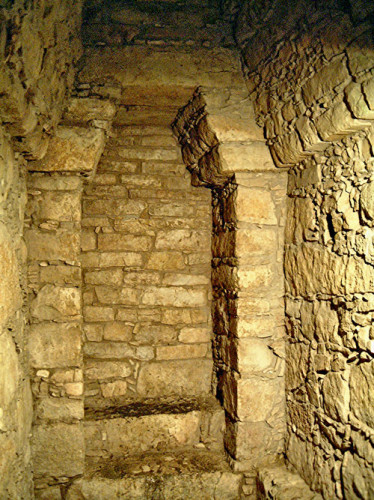 Antechamber of Temple XIIIWhilst the bones of the Red Queen of Palenque were contaminated by the cinnabar, the bones of the 10 year old boy and 30 year-old female who had been entombed as her companions, had been well preserved. Radio carbon dating demonstrated that the boy had died between 540-660AD and the girl had died between 650AD-780AD – leaving a small overlap of 650AD-660AD as the most likely date they died. Archaeologists had already deduced that the Tomb of the Red Queen, Temple XIII, had been built between 500-700AD and pottery sherds suggested that it was towards the end of this period that the Red Queen of Palenque had been buried. Although reburial was often carried out as a means to communicate with an ancestor, cleanse their bones and comfort their spirit after its initial journey, the skeleton of the Red Queen of Palenque was complete and each of the hundreds of bones were perfectly ordered – which would have been an impossible task if the skeleton had been reburied. Therefore, Yohl Ik Naal, who died in 604AD, could not be the Red Queen of Palenque, but both Sak K’uk, who died in 640AD, and Tz’akbu Ajaw, who died in 672AD were both still equally strong candidates to have been buried in the Tomb of the Red Queen.
Antechamber of Temple XIIIWhilst the bones of the Red Queen of Palenque were contaminated by the cinnabar, the bones of the 10 year old boy and 30 year-old female who had been entombed as her companions, had been well preserved. Radio carbon dating demonstrated that the boy had died between 540-660AD and the girl had died between 650AD-780AD – leaving a small overlap of 650AD-660AD as the most likely date they died. Archaeologists had already deduced that the Tomb of the Red Queen, Temple XIII, had been built between 500-700AD and pottery sherds suggested that it was towards the end of this period that the Red Queen of Palenque had been buried. Although reburial was often carried out as a means to communicate with an ancestor, cleanse their bones and comfort their spirit after its initial journey, the skeleton of the Red Queen of Palenque was complete and each of the hundreds of bones were perfectly ordered – which would have been an impossible task if the skeleton had been reburied. Therefore, Yohl Ik Naal, who died in 604AD, could not be the Red Queen of Palenque, but both Sak K’uk, who died in 640AD, and Tz’akbu Ajaw, who died in 672AD were both still equally strong candidates to have been buried in the Tomb of the Red Queen.
The skull of the Red Queen of Palenque provided many clues: the sutures were sufficiently fused to demonstrate it was an elderly lady, between 50-60 years of age; the teeth showed very little wear which suggests she enjoyed a diet of well-prepared high-protein foods; the skull had been subject to cranial deformation and was marked by the strapping which had been used – a clear indication she was of noble upbringing; a hole in the top of the skull suggested that trepanation had been carried out to relieve pressure and this had increased in size following the operation, probably due to osteoporosis which was caused by pregnancy in later life; the imbalances in oestrogen caused by late pregnancy had also resulted in abscesses, which were evidenced around the jaw. All the evidence pointed to woman that had led a long life beset with illnesses caused by pregnancy in older age, which had been well treated. She had also been well cared for and had led a protected life, which enabled her to live through the pains of osteoporosis without breaking a single bone. The Red Queen of Palenque was certainly a member of the elite and had been born into nobitlity – but none of these facts could determine whether the Tomb of the Red Queen contained the body of Sak K’uk or Tz’ukbo Ajaw.
However, two scientific tests did bring about conclusive evidence of who was laid to rest in the Tomb of the Red Queen. The first test was performed on strontium isotopes extracted from the teeth of the Red Queen of Palenque. The results demonstrated that the Red Queen of Palenque was an outsider, someone who was raised in the region around Palenque, because the geological profile did not match those of Pakal – who it is assumed did grow up at Palenque. The second test was to extract mitochondrial DNA from the bones of the Red Queen, which was greatly complicated by the cinnabar powder bonding with the DNA and causing it to fragment. The resulting electropherogram did sufficiently identify polymorphisms that showed the Red Queen of Palenque was not related to K’inich Janab Pakal. This left just one possibilty, the Tomb of the Red Queen must have been for Pakal’s wife, Tz’akbu Ajaw. However, this assumes that Sak K’uk was related to Pakal, which is not a certainty. A third test, looked at rebuilding the facial features of the Red Queen of Palenque using forensic reconstruction techniques. This was a plausible means of identification, because Mayan art had a strong emphasis on realism and at Palenque the portraits of the various rulers are easily distinguishable. The resulting facial reconstruction matched closely with the profile portraits of Tz’akbu Ajaw, which seems to conclusively demonstrate that it was Tz’akbu Ajaw who was buried in the Tomb of the Red Queen and it seems likely that Pakal had his wife buried in this unusual manner that he too intended to be buried in.
Further Reading:
http://www.mesoweb.com/palenque/features/red_queen/01.html

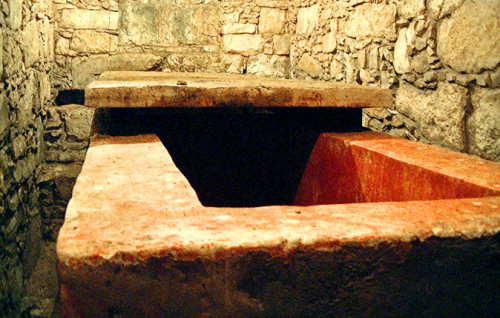
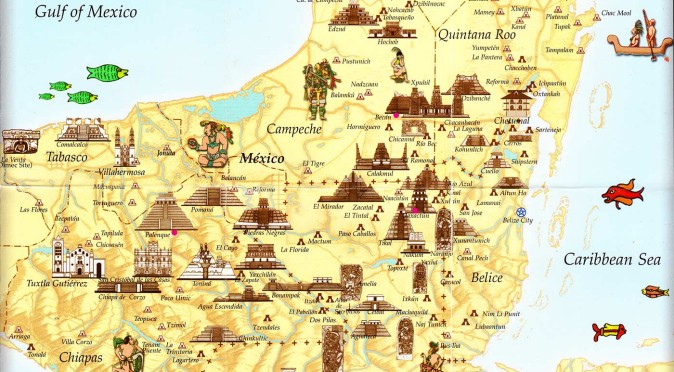
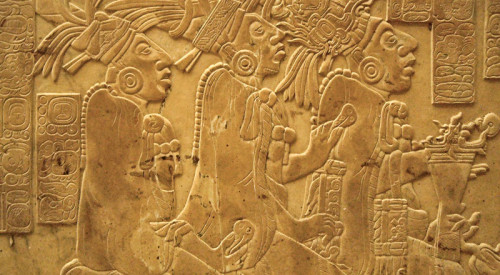
Excellent article. Good summary of the scientific evidence on behalf of the red queen being the wife of the great Pakal.
Walter
Stumbled across your site while doing some research on the Maya and I have to say I’m finding your work incredibly helpful and informative for the way you explain everything so clearly and with so many photos. I haven’t been to these sites yet but this is so great for helping me visualise what I will see when I get there! Great work, thank you!
Thanks Bella!